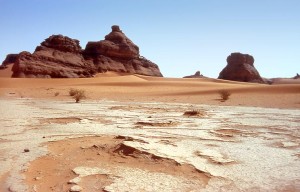
Different people living differently in different places still have these common needs: to have something to eat and drink in order to survive. In the desert for instance, food is still the main problem to endure.
The desert is a kind of place that receives minimal amount of rainfalls, a dusty and rocky place where no life seems to exist. In fact, due to the scarcity of water and moisture, vegetation and plants could hardly exist.
In some hot deserts, the average temperature in the daytime is about 45 °C or 113 °F, or even higher during summertime . In nighttime however, it would reach to 0 °C or 32 °F and it could be lower than in some winter nights.
On the other hand, Polar deserts, which are also called cold deserts, have similar deficient precipitation in the form of snow instead of rainfall. Antarctica is known as the largest cold desert in the world. The whole continent is covered with a thick ice-surface which makes up 98% and the remaining 2% contains solid rocks.
There are a number of deserts in the world including the Antarctic Desert in Antarctica, Sahara (the world’s largest hot desert) and Kalahari in Africa, Gobi in Asia, Syrian Desert in Middle East, Patagonian in South America and Great Basin in North America and many others, most of them inhabited by human beings.
The land area in Sahara in North Africa covers around 12 countries with an area of more than 9 million square kilometers. It may have rainfalls twice in a week and never again to receive even a single precipitation for many years ahead. Humans somehow manage to survive because of oases scattered throughout the Sahara desert. Since the last ice age, people occupy the edge of the desert, some living near the oasis or any moist place up to the present.
Sahara desert plants play a vital role for survival in Sahara’s unforgiving environment. They can easily adapt to harsh conditions that’s why they can grow either in sandy or salty environment such as in salt marshes, semi-deserts and in sea coasts. These plants grow naturally even with scarce water supply because they can hold water for long. Some of them have extremely deep roots that sip water from deep soil.
Some of the deserts plants in Sahara are the different types of cactus, thyme, eragrostis, olive, date and doum palm which are the most important desert plants. Palm trees are the main sources of food for the natives. Aside from palm oil, one of the exported products in Sahara desert, it also serves as food. The seeds can be ground to make flour for baking bread and its leaves can be cooked as vegetables. Another well-known tree not only in Sahara but also in other countries is the olive. Olive trees are the most profitable business Sahara. Olive products are being exported to some other countries as the source of the region’s revenue.
If you think of life in this vast region with almost no precipitation, searing heat from the sun, you certainly would want to live in a place full of water, or even in frozen places, as long as it has cool and fresh air. People living in the desert somehow got used to it. Some don’t even know that there are places in the world that are more convenient, and even if they do, they would rather choose to live and die in this place they can call their own – the desert.
Recommended Articles:






